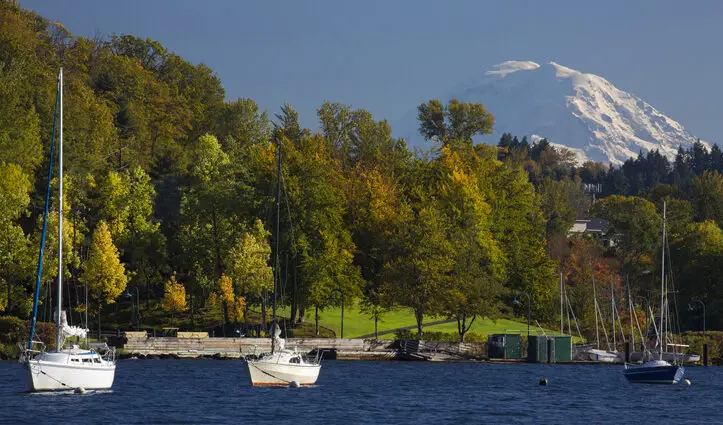TL;DR (Too Long; Didn’t Read) Lake Washington, situated in Seattle, is a massive freshwater lake with a surface area of 22,138 acres, spanning over 22 miles from north to south. Known for its historical significance, the lake was home to Native American tribes and witnessed European exploration and urban development. It offers a wide range of recreational activities like boating, fishing, swimming, and has a diverse ecosystem that is crucial for the region’s environmental health. Preserving its beauty and water quality is vital for future generations to enjoy this natural treasure.
Seattle, known for its picturesque landscapes, lush greenery, and vibrant urban culture, is a city surrounded by natural beauty. One of the most prominent attractions in this region is Lake Washington.
Spanning across the eastern border of the city, Lake Washington is a significant body of water that holds historical, recreational, and ecological importance. In this article, we will delve into the details and dimensions of Lake Washington, exploring its vastness, history, and the activities it offers to residents and visitors alike.
Lake Washington’s Dimensions
| Lake Washington’s Dimensions | Measurements |
|---|---|
| Surface Area | 22,138 acres |
| Length (North to South) | 22 miles |
| Average Width | 1.4 miles |
| Deepest Point | 214 feet |
| Shoreline Length | 52 miles |
The Basics
Lake Washington, an impressive freshwater lake, is situated in King County, Washington. Spanning over 22 miles from north to south, the lake is a prominent and defining feature of Seattle’s landscape. With an average width of approximately 1.4 miles, the lake boasts a total surface area of around 22,138 acres.
Shoreline and Depth
Lake Washington has an extensive shoreline that stretches over 52 miles, offering ample opportunities for waterfront activities, relaxation, and breathtaking views. Along with its vast shoreline, the lake’s depth is another notable feature. With its deepest point reaching a staggering 214 feet, Lake Washington is considered one of the deepest lakes in the United States.
Islands and Bridges
Numerous islands dot the surface of Lake Washington, adding to its charm and allure. Mercer Island, situated roughly in the middle of the lake, is the largest and most well-known island. Other notable islands include Foster Island, Marsh Island, and Evergreen Point. The latter is home to the world-famous Evergreen Point Floating Bridge, also known as the Governor Albert D. Rosellini Bridge, which connects Seattle to Medina.
Lake Washington is a regional and national treasure that provides drinking water, a place to swim and fish, and habitat for fish and wildlife.
King County, Washington
Historical Significance
Native American Presence
Lake Washington holds deep historical significance, particularly for the Native American tribes that lived in the region for thousands of years. The lake and its surrounding areas were home to the Duwamish, Suquamish, and other tribes. These tribes relied on the lake for food, transportation, and cultural ceremonies. It was a vital part of their daily lives and played a significant role in their rich traditions and heritage.
European Exploration and Settlement
The first recorded European to explore Lake Washington was Captain George Vancouver in 1792. However, it was not until the mid-19th century that settlements began to emerge in the area. The arrival of pioneers and the subsequent development of Seattle in the late 1800s brought rapid growth and urbanization to the region, forever altering the landscape around the lake.
Transformation and Urban Development
Over the years, Lake Washington has witnessed significant transformations due to urban development and infrastructure projects. The construction of the Lake Washington Ship Canal in the early 20th century led to the lowering of the lake’s water level by around 9 feet. This project created a navigable waterway and facilitated the growth of Seattle’s port, enhancing its economic importance.

Recreational Activities
Boating and Water Sports
Lake Washington offers a plethora of opportunities for boating enthusiasts and water sports lovers. Whether it’s sailing, kayaking, paddle boarding, or waterskiing, the expansive waters of the lake provide a perfect playground for aquatic adventures. Rental services, marinas, and public boat launches are available to cater to both residents and visitors who wish to explore the lake’s beauty from its serene waters.
Fishing
Fishing enthusiasts are drawn to Lake Washington for its diverse population of fish species. The lake is particularly renowned for its abundance of trout, including rainbow trout, cutthroat trout, and brown trout. Other popular fish species in the lake include bass, perch, and salmon. Anglers can be seen casting their lines from the shore, docks, or boats, enjoying the peacefulness of the lake while waiting for their next catch.
Swimming and Beaches
During the warm summer months, Lake Washington’s many beaches become popular destinations for swimmers and sunbathers. Parks such as Gene Coulon Memorial Beach Park in Renton, Madison Park Beach, Juanita Beach Park, and Matthews Beach Park provide public access to the lake’s shoreline. These beaches offer sandy shores, picnic areas, and swimming areas with lifeguards on duty, ensuring a safe and enjoyable experience for all.
Environmental Importance
Ecosystem
Lake Washington supports a diverse ecosystem that is vital for the overall health of the region. Its waters are home to a variety of fish, aquatic plants, and other wildlife. The lake also serves as a stopover for migratory birds, making it a significant habitat for avian species. Preservation efforts and environmental initiatives aim to sustain the lake’s ecosystem and protect its biodiversity for future generations.
Water Quality
Maintaining water quality is of utmost importance to ensure the health and sustainability of Lake Washington. Ongoing efforts by government agencies and community organizations monitor and address water pollution concerns. Initiatives such as stormwater management, wastewater treatment, and reducing pollution from urban runoff contribute to improving and preserving the lake’s water quality.
Conclusion
Lake Washington, with its vast expanse of shimmering blue waters, is an integral part of Seattle’s identity. Its dimensions and historical significance, coupled with the array of recreational activities it offers, make it a beloved destination for residents and visitors alike. As we marvel at its vastness and enjoy its many amenities, let us also remember to preserve and protect this natural gem for future generations to come.
FAQ
Lake Washington spans over 22 miles from north to south, with an average width of approximately 1.4 miles and a surface area of around 22,138 acres.
Lake Washington is considered one of the deepest lakes in the United States, with its deepest point reaching a staggering 214 feet.
Lake Washington held significance for Native American tribes, served as an exploration site for European settlers, and witnessed urban development that transformed the region.
- What Size is Regular Printer Paper? Quick Guide for Paper Dimensions - June 18, 2023
- What Size is My Monitor: A Comprehensive Guide - June 18, 2023
- How Big is Italy Compared to the US? A Concise Comparison - June 16, 2023

